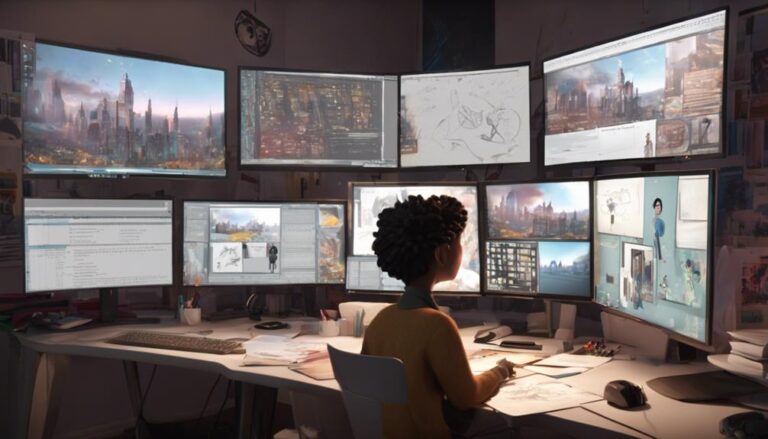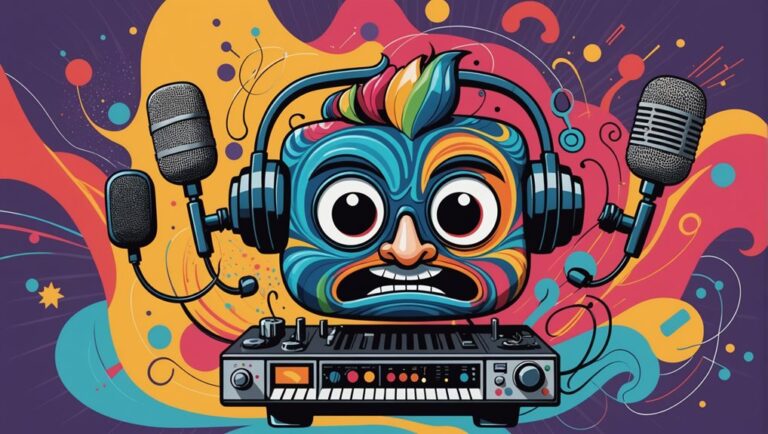Why VR Animation Scripts Need a Unique Format
When you create a VR animation, you're not just telling a story – you're crafting an immersive experience that needs a custom approach. Traditional script formats don't account for the unique aspects of VR, like 360-degree camera angles, spatial audio, and interactive hotspots. You need a script that can accommodate these elements and ensure a seamless experience. As you move forward with your project, you'll see that formatting your script in a way that addresses these specifics is crucial. As you explore the nuances of VR storytelling, you'll discover the importance of tailored scripting for a truly engaging experience.
Key Takeaways
- VR animation scripts require unique formatting to accommodate interactive and immersive elements.
- Traditional script formats are not suitable for VR animation due to non-linear storytelling techniques.
- Script templates specifically designed for VR animation help organize scripts and ensure necessary elements.
- Unique formatting includes sections for 360-degree camera angles, spatial audio cues, and interactive hotspots.
- Real-time feedback and iterative development processes also inform the need for tailored VR animation script formats.
Understanding VR Storytelling Challenges
Immersing yourself in a virtual reality (VR) world can be a thrilling experience, but it also poses unique storytelling challenges that you'll need to overcome.
As you develop your VR animation script, it's essential to consider the immersive nature of the medium and how it affects the story arc. A traditional linear narrative may not be the most effective approach in VR, where the viewer has agency and can influence the experience.
To craft a compelling story in VR, you need to create an emotional connection with your audience.
This can be achieved by incorporating emotional triggers that resonate with your viewers. These triggers can be subtle, such as a character's expression or a specific sound effect, or more overt, like a dramatic plot twist. By using emotional triggers effectively, you can create a more immersive and engaging experience for your audience.
When structuring your story arc, consider the VR environment and how it can enhance the narrative.
Use the unique aspects of VR to your advantage and experiment with non-linear storytelling techniques to create a truly immersive experience.
Spatial Relationships and Blocking
When creating VR animation scripts, you'll need to consider the spatial relationships between characters, objects, and the environment to ensure a believable and immersive experience.
Effective character placement strategies are crucial in establishing these relationships and guiding the viewer's attention.
Character Placement Strategies
Effective character placement is key to crafting believable scenes in VR animation.
When you're directing a scene, it's essential to consider character motivations and how they relate to the environment. This helps to create a cohesive and immersive experience for the viewer.
You'll want to think about how your characters interact with each other and their surroundings, using environmental clues to inform their placement.
For example, if two characters are having a conversation, you might want to position them near a coffee table or in a park. This helps to create a sense of realism and depth.
To evoke emotion in your audience, consider the following character placement strategies:
- Use proximity to convey intimacy or tension between characters
- Position characters to create a sense of power dynamics or hierarchy
- Use environmental obstacles to block or reveal characters
- Place characters in areas that reflect their personality or traits
- Experiment with height and level to create a sense of drama or unease
Virtual Stage Blocking
You're now tasked with arranging your characters in 3D space to convey the narrative and emotional arcs of your scene.
Virtual stage blocking is crucial in VR animation, as it influences the viewer's perception of the scene. To achieve this, consider the spatial relationships between characters, props, and the environment.
Think about how characters will move and interact with each other and their surroundings.
Director guidance is essential in virtual stage blocking. The director's vision should be clearly communicated to ensure that the blocking aligns with the overall narrative.
Virtual rehearsals can be conducted to test and refine the blocking. These rehearsals allow the director to provide feedback and make adjustments in real-time.
When blocking your scene, consider factors such as character proximity, movement paths, and eye lines.
These elements can significantly impact the emotional impact of the scene.
By carefully planning and executing virtual stage blocking, you can create a more immersive and engaging VR experience.
Effective blocking can also help to reduce the need for costly reworks and revisions during post-production.
Audience Perspective and Immersion
A single, well-crafted shot in VR animation can transport an audience into the heart of the action.
As you craft your VR animation script, consider how to harness the power of perspective to create a fully immersive experience.
By shifting the audience's perspective, you can evoke emotions, build empathy, and create a deeper connection with your story.
To evoke emotion in your audience, consider the following techniques:
- Use close-ups to put the audience in the midst of intense action sequences, making them feel like they're part of the scene.
- Employ bird's-eye views to give the audience a sense of scale and grandeur, emphasizing the magnitude of the scene.
- Utilize first-person perspectives to create a sense of intimacy and immediacy, drawing the audience into the character's thoughts and feelings.
- Incorporate Dutch angles to create a sense of unease or disorientation, mirroring the character's emotions.
- Use wide shots to establish the setting and create a sense of context, helping the audience understand the world of the story.
Interactive Elements in VR
By leveraging the power of perspective, you've created a foundation for an immersive VR experience. Now, it's time to incorporate interactive elements that engage users and enhance their experience. Interactive cues and environmental triggers are crucial in this process.
When designing interactive elements, consider the user's role and how they'll interact with the environment. This will help you create a seamless and intuitive experience.
Interactive Elements in VR
| Element | Description | Trigger |
|---|---|---|
| Teleportation | Allows users to move between locations | Controller gesture |
| Object manipulation | Enables users to interact with objects | Hand-tracking or controller |
| Environmental effects | Simulates real-world effects, such as wind or water | Environmental triggers |
| Character interactions | Facilitates communication with virtual characters | Voice commands or gestures |
| Puzzles | Challenges users to solve problems | Environmental triggers or object manipulation |
Adapting to 360-Degree Storytelling
As you transition to 360-degree storytelling in VR, it's essential to rethink traditional narrative structures.
The immersive nature of VR demands a unique approach to pacing and storytelling evolution. You'll need to consider the viewer's freedom to look around and interact with the environment, which can greatly impact the narrative flow.
To evoke emotion in your audience, focus on these key elements:
- Create an emotional connection with the viewer by placing them in the midst of the action.
- Use spatial audio to enhance the sense of presence and immersion.
- Employ subtle visual cues to guide the viewer's attention and create a sense of tension.
- Design interactive elements that allow the viewer to influence the story, increasing their emotional investment.
- Experiment with non-linear storytelling to create a sense of agency and discovery.
Scripting for Dynamic Cameras
Dynamic cameras play a pivotal role in shaping the VR viewer's experience.
When scripting for dynamic cameras, you need to consider how camera movements will enhance the narrative and fully immerse the viewer in the virtual world. Unlike traditional 2D animation, VR requires a more nuanced approach to camera movements, as viewers can look around and interact with the environment.
To achieve this, you'll want to plan and script dynamic shots that complement the scene's action and pacing.
This could include sweeping crane shots, intimate close-ups, or immersive point-of-view shots. When writing your script, consider how camera movements will guide the viewer's attention and create a sense of tension or drama.
As you script, think about the camera's position, movement, and speed.
Will it be static or dynamic? Will it follow a character or object? By carefully planning and executing camera movements, you can create a more engaging and immersive VR experience.
Effective scripting for dynamic cameras requires a deep understanding of VR storytelling principles and the ability to balance technical considerations with creative vision.
Incorporating Real-Time Feedback
Incorporating real-time feedback into your VR animation script can significantly enhance the viewer's experience, making interactions feel more responsive and immersive.
By integrating real-time feedback, you can ensure that your VR animation is engaging, interactive, and truly immersive. This approach also enables real-time iteration, allowing you to refine your script and make adjustments as needed.
Some benefits of incorporating real-time feedback into your VR animation script include:
- *Reduced latency*: Real-time feedback ensures that interactions are responsive and immediate, reducing the latency that can detract from the viewer's experience.
- *Improved testing*: Collaborative testing becomes more effective with real-time feedback, as team members can instantly see the impact of their changes.
- *Enhanced creativity*: Real-time feedback can also foster creativity, as you can experiment with different ideas and see the results immediately.
- *Increased efficiency*: Real-time iteration streamlines the development process, allowing you to make changes and adjustments on the fly.
- *Better decision-making*: With real-time feedback, you can make informed decisions about your VR animation script, based on immediate results and feedback.
Format Changes for VR Success
To achieve this, consider using script templates specifically designed for VR animation.
These templates will help you organize your script and ensure that you're including all the necessary elements for a successful VR experience.
For example, you may want to include sections for 360-degree camera angles, spatial audio cues, and interactive hotspots.
Frequently Asked Questions
Can VR Animation Scripts Be Used for Film Adaptations?
You can adapt VR animation scripts for film, but you'll need to rework the cross-platform storytelling and visual narrative to fit a more linear format, losing some of the interactive elements that made it immersive in VR.
How Does VR Affect the Writer-Director Relationship?
When you work in VR, you're redefining the writer-director relationship. You're navigating virtual boundaries, which can either hinder or enhance creative collaborations. Effective communication becomes key to overcoming these unique challenges and bringing your vision to life.
Are VR Scripts More Expensive to Produce Than Film Scripts?
You'll find that VR scripts can be more expensive to produce due to increased script complexity, requiring more detailed scene descriptions and stage directions, which can strain your budget constraints.
What Software Is Used for Writing VR Animation Scripts?
You'll find that popular scriptwriting apps, like Fade In and Final Draft, can be used for writing VR animation scripts, while virtual notebooks like Simplenote and Evernote also help organize your ideas and storylines efficiently.
Can VR Scripts Be Used for Other Immersive Technologies?
You can repurpose VR scripts for other immersive technologies, like AR and MR, by leveraging cross-platform compatibility and adapting immersive storytelling elements to each platform's unique strengths and limitations for a seamless experience.
Conclusion
You've made it to the final step in understanding why VR animation scripts need a unique format. By now, you know spatial relationships, audience perspective, and interactive elements all play a role in shaping your narrative. To succeed in 360-degree storytelling, you must adapt your script to accommodate dynamic cameras and real-time feedback. By making these format changes, you'll be well on your way to creating immersive VR experiences that leave a lasting impact on your audience.






